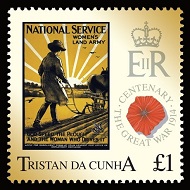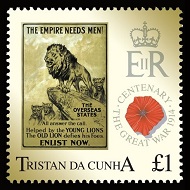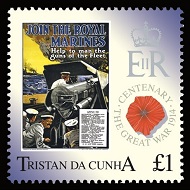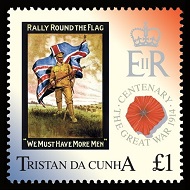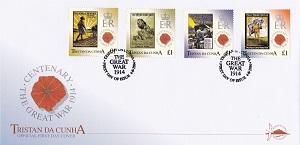|
When Great Britain formally declared war on Germany on the 4th August 1914, it did so, not in isolation but on behalf of itself, its Colonies and Dominions. Although not required by their constitutions to provide 'troops' to Great Britain, it transpired that all of the Dominions did do so during this, 'The War to End All Wars'.
Whilst not strategically important at this time, Tristan da Cunha as a Dependency of the Colony of St Helena was party to the Declaration of War, although, following the defeat of the German Fleet in the South Atlantic in December 1914 at the Battle of the Falkland Islands, it did not play any significant role.
The Tristan da Cunha Post Office has decided therefore that rather than depict images of War in which no inhabitant participated, it would remember the Propaganda benefit of the numerous War Posters issued. In today's modern world, we are used to e-mails, tweets and of course TV coverage, so, news is available literally on a minute by minute basis.
In 1914, without even the BBC transmitting radio programmes, the only methods of widespread communication were newspapers, letters, word of mouth and posters displayed in prominent public areas.
Each of the nations involved in World War I used propaganda posters both as a way of justifying their involvement in the war, but also as a means of obtaining men, money and resources to continue the fight.
In Britain in particular, the use of propaganda posters was very important as in 1914 it only possessed a professional army and did not have a policy of national service, as was the norm in other major nations such as France and Germany.
While the use of posters was initially successful in Britain the numbers required for active service at the Front were such as to ultimately require the introduction of conscription. Despite this, recruitment posters remained in use for the duration of the war.
Wartime posters were not just used to recruit men to fight. Posters commonly urged wartime thrift, and were useful in seeking funds from the general public encouraging them to buy war bonds or to help in the battle to grow more food.
Interestingly, although the U.S.A. only joined the war in April 1917 she produced many more propaganda posters than any other single nation.
In recognition of the outbreak of World War I the Tristan da Cunha Post Office is issuing a set of four stamps depicting iconic posters approved and in most cases, issued by the British Government.
Each stamp is denominated £1 and bears a specially produced logo which contains the shape of the island of Tristan da Cunha as a Poppy within a circle which declares 'Centenary The Great War 1914'.
The posters themselves depict;
'National Service - Women's Land Army'
Designed by Henry Gawthorn and printed in 1917.
The Board of Agriculture organised the Land Army during the Great War, starting activities in 1915. Towards the end of 1917 there were over 250,000 women working as farm labourers, with 20,000 in the land army itself.
With 3 million men away to fight in the First World War Britain was struggling for labour. The government wanted women to get more involved in the production of food and do their part to support the war effort and thus the Women's Land Army was born.
'The Empire Needs Men'
Designed by Arthur Wardle, the original version was published by The Parliamentary Recruitment Committee in 1915. The Recruitment drive was aimed not just at British Citizens but also those of the Dominions who were not obliged to join up. The 1915 version referred to Australia, Canada, India and New Zealand with South Africa excluded as there was some doubt as to its likely support. This later version referred to the Overseas States and therefore included South Africa.
The mature Lion symbolises Great Britain and the young Lions the Dominions.
'Join the Royal Marines. Help to Man the Guns of the Fleet'
Published by the Admiralty Recruiting Department, 1915 and printed by W Smith London.
The poster shows Marines at their stations on a Royal Navy Ship, ready to exchange fire with the enemy. It also gives details of recruiting offices in Great Britain and the Channel Islands.
'Rally Round the Flag - We Must Have More Men'
Published by the War Office in 1914 and designed by Collett.
A British infantryman stands against a Union flag, his rifle and bayonet at the ready. In the background two field-gun teams advance towards the horizon.
|

